
Sahara Desert facts: get the lowdown on one of Earth’s most remarkable places.
Discover More With Active Wild
You can find out more about deserts on this page: Deserts
You can see more amazing places on this page: Amazing Places
You can see more deserts on this page: Deserts Of The World
Discover amazing animals that live in deserts on this page: Desert Animals
Discover amazing North American deserts on this page: North American Deserts
Sahara Desert Facts: Introduction
The Sahara Desert covers an area of 9.2 million square kilometers / 3.5 million square miles, and is the largest hot desert in the world.
The Sahara desert is roughly the same size as the United States. (The area of the USA is 9.834 milllion km2 / 3.797 sq mi including water, and 9.148 million km2 / 3.53 sq mi without.)
The only deserts that are bigger than the Sahara are Antarctica and the Arctic, which are cold deserts.
The Sahara desert’s name is derived from the Arabic for “desert”.

Where is the Sahara Desert Located?
The Sahara Desert is located in North Africa. It covers parts of Algeria, Chad, Egypt, Libya, Mali, Mauritania, Morocco, Niger, Western Sahara, Sudan and Tunisia.
The map below shows the location of the Sahara Desert. You can’t miss it: it’s the huge expanse of yellow that covers most of the top of Africa!
Sahara Desert Borders
The Sahara Desert is bordered by the Mediterranean Sea and the Atlas Mountains to the north, and by the Sahel (a belt of hot, semi-arid savannas and grasslands surrounding the Niger River valley) and the Sudan Region to the south.
To the west, the desert is bordered by the Atlantic Ocean, and to the east by the Red Sea.
Was The Sahara Desert Always A Desert?
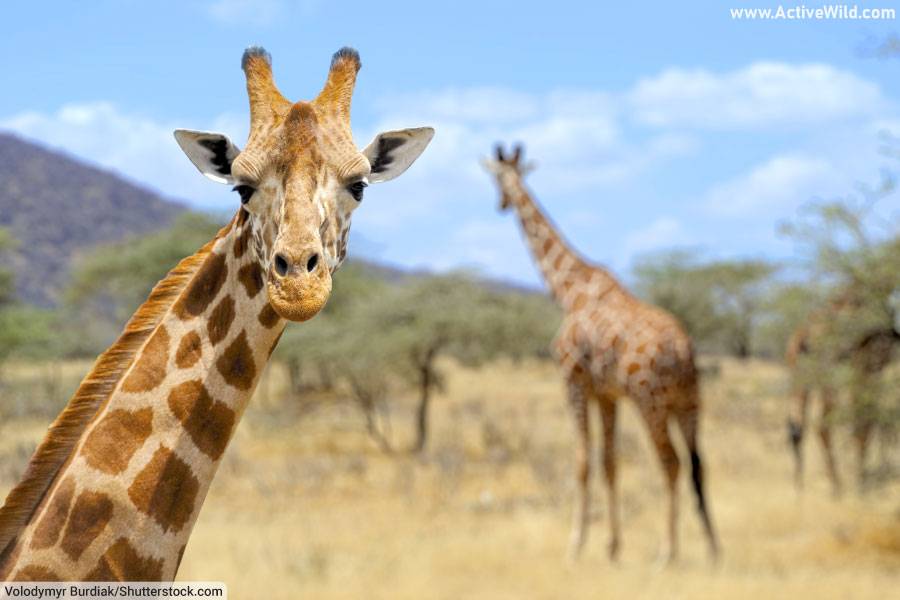
The region covered by the Sahara Desert has not always been a desert, and has undergone significant climatic shifts throughout its geological history.
Around 7 million years ago, during the late Miocene era, the Sahara was a savannah-like environment. From about 5.5 million to 5.3 million years ago, it transformed into a desert due to a shift in the Earth’s axes, which altered global weather patterns.
However, it was not a permanent shift. Over the next several million years, the Sahara oscillated between desert and grassland states, in sync with the Earth’s precession (the slow wobble of the planet’s rotational axis), which changes the location of the North African monsoon.
During humid periods, known as “Green Sahara” or “African Humid Periods“, the desert was dotted with lakes, rivers, and diverse ecosystems with a variety of flora and fauna.
The most recent of these periods happened approximately between 14,000 and 5,500 years ago, during the Holocene epoch.
Rock paintings from the time, found by explorers in the mid-1800s, depict humans hunting large game such as elephants, giraffes and hippos – species no longer able to inhabit the inhospitable desert.
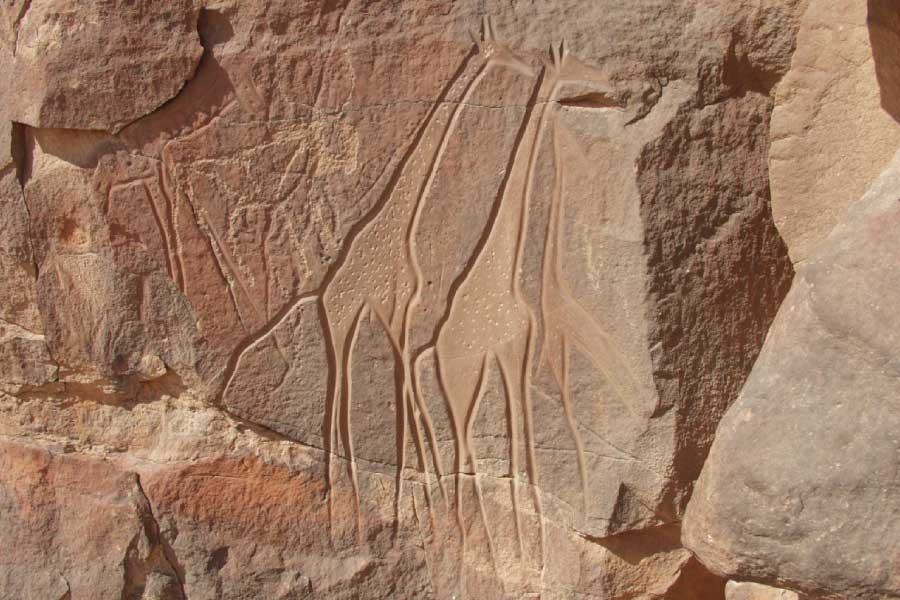
Around 5,500 years ago, the Sahara entered its current dry phase due to another shift in Earth’s orbit, which decreased the amount of monsoon rainfall. This shift led to a gradual desiccation of the Sahara, with human societies that once thrived there migrating to the Nile Valley and other fertile areas.
Sahara Desert Climate
The climate of the Sahara Desert is one of the most extreme on Earth, characterized by aridity, high temperatures, strong winds, dramatic temperature swings, and minimal rainfall.
Temperature
Temperatures in the Sahara can be extreme, varying significantly between day and night.
During the day, temperatures can exceed 50 degrees Celsius (122 degrees Fahrenheit) in the hottest months, typically from May to September.
At night, the desert can become surprisingly cold, with temperatures frequently dropping below freezing during the winter months, especially in the northern and southern edges of the desert.
Rain
Precipitation is sparse and irregular in the Sahara, with large areas often receiving less than 25 millimeters (1 inch) of rain per year. Some parts of the desert may not see rain for several years. When it does rain, the water quickly evaporates or is absorbed by the sand due to the intense heat.
Wind
Wind is another important factor in the Sahara’s climate. The desert is frequently swept by strong winds, which are capable of forming vast dune fields and causing sand storms and dust devils.
The most prevalent wind, the harmattan, blows from the northeast and can carry dust as far as the Atlantic Ocean.
Sahara Desert Landscape
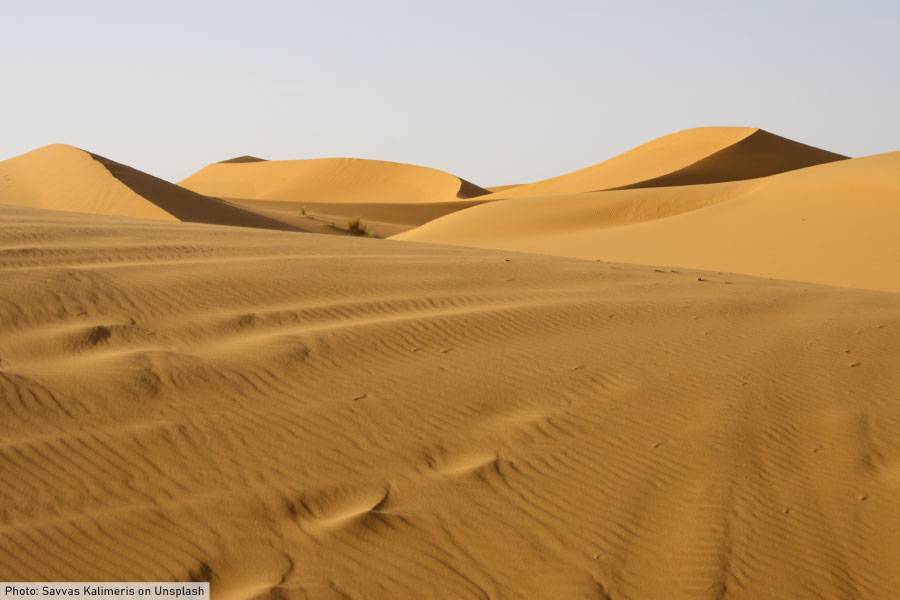
The Sahara Desert presents a stark yet diverse landscape characterized by vast, sandy dunes, rocky plateaus, scattered oases, and sparse vegetation, all under a relentless, blazing sun.
Although the Sahara Desert is often depicted as a vast sea of rolling sand dunes, in reality, sandy deserts comprise just about 20-25% of the Sahara.
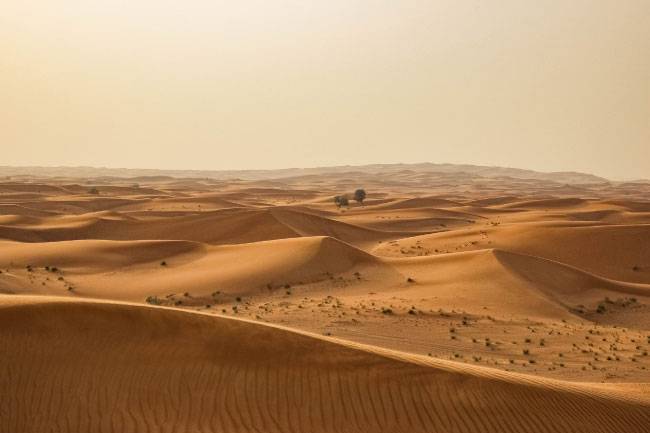
The rest of the landscape is made up of bare, rocky plateaus, mountains, gravel plains, dry valleys, and salt flats.
The large sandy areas are known as ergs. These areas of desert are covered with wind-swept sand and dunes, creating a sea-like expanse of undulating, shifting sands. Here, dunes rising up to 180 meters (590 feet) tall can be found.
One of the largest areas of sand desert in the Sahara is the Grand Erg Oriental, which spans parts of Algeria and Tunisia.
Sahara Desert Plants
You can see more examples of plants that grow in deserts on this page: Desert Plants
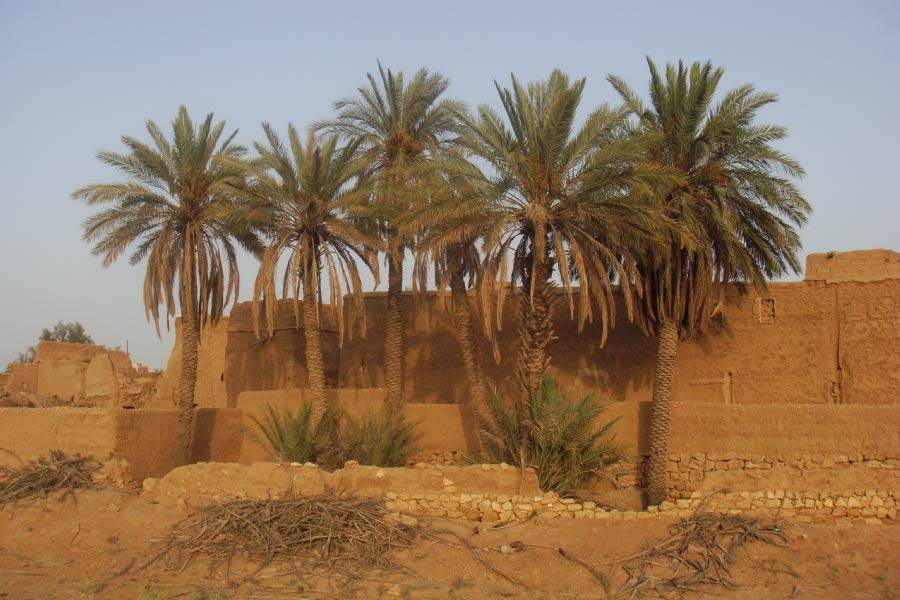
Despite its reputation as a barren wasteland, the Sahara Desert is home to a range of vegetation well-adapted to the harsh arid conditions.
Over 500 species of plants have been recorded in the central Sahara Desert, though their distribution is extremely sparse and largely confined to areas where water is more readily available, such as oases or along river beds.
The desert’s flora includes varieties of grasses, shrubs, and trees that have developed special adaptations to cope with the desert’s arid conditions, such as deep root systems to tap into underground water reserves, small or waxy leaves to reduce water loss, and the ability to remain dormant during the driest periods.
An iconic Sahara plant is the date palm, found in oases where water is available. Other plants found in the Sahara Desert include the acacia tree, the doum palm, the desert gourd, and the camel thorn.
Many of these plants also play crucial roles in the ecosystem, providing food and shelter for the desert’s fauna and helping to stabilize the sand dunes with their roots.
Sahara Desert Animals
You can see more desert animals on this page: Desert Animals
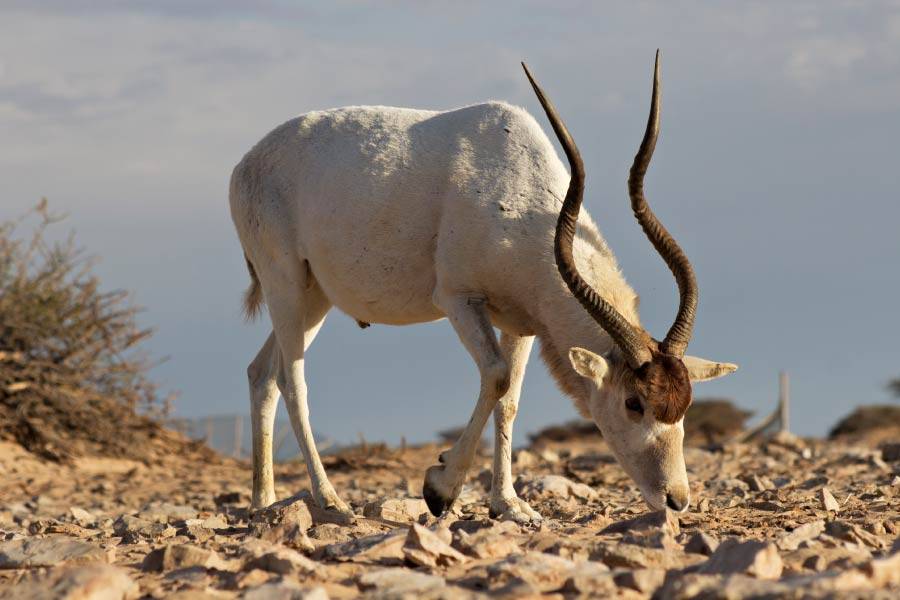
The Sahara Desert, despite its harsh and inhospitable conditions, is home to a range of resilient animals, many of which have adaptions for coping with the extreme climate.
Large mammals found in the Sahara include the addax, a large, critically endangered white antelope, dorcas, rhim and dama gazelles, the Saharan cheetah (a rare cheetah subspecies) and a small number of African wild dogs.
Smaller mammals include the fennec fox, jerboas, North African gerbil, and the desert hedgehog.
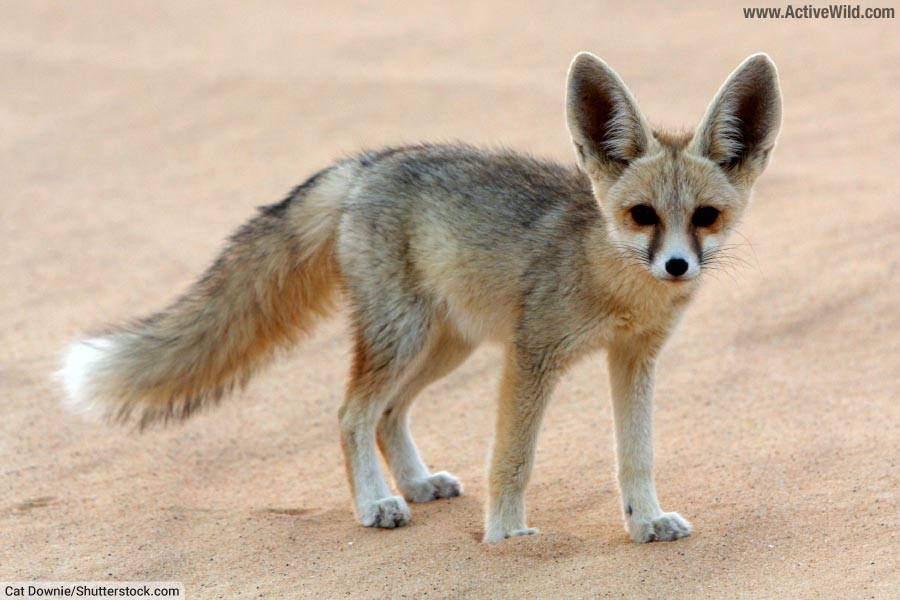
Reptiles found in the Sahara region include the desert monitor lizard, skinks, and snakes such as the horned viper and the Sahara sand viper.
Birds like the Namaqua dove, African silverbill, lappet-faced vulture, ostrich, and African silverbill can also be found.
Notably, many of these animals are nocturnal, venturing out during the cooler nights to forage or hunt, and then taking shelter during the heat of the day.
Crocodiles, frogs and toads are found in the few areas of the desert in which water is present.
The video below shows how swallows migrate over the Sahara.
People Of The Sahara Desert
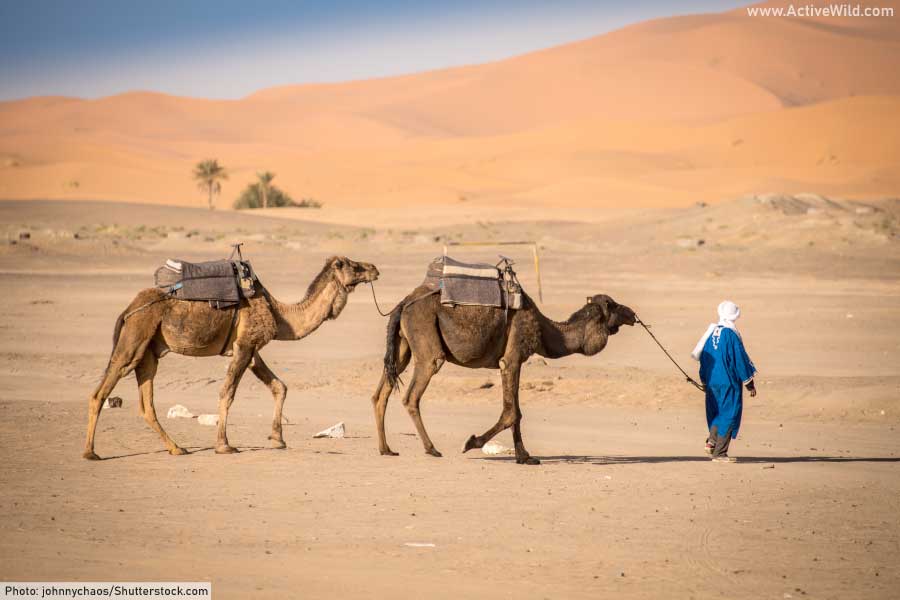
The Sahara Desert is home to various cultures and people who have adapted to its harsh conditions over thousands of years. In 2015, it was estimated that around 2.5 million people lived in the desert.
Notable groups include the nomadic Tuareg, known as the “blue people” due to their indigo-dyed clothing; the Berber people, who reside in the mountainous regions of the Sahara and engage in pastoralism, farming, and trading; and the Bedouin, found primarily in the eastern Sahara, known for their nomadic lifestyle, animal husbandry, and guidance of caravans.
Changing environmental and economic conditions, such as the discovery of oil and mineral resources, have led to a more sedentary lifestyle for many previously nomadic people, with growing towns and cities in areas with access to water reserves.
Despite these shifts, the people of the Sahara maintain a strong connection to their historical cultures and traditions.
UTA Flight 772 Memorial
On September 19, 1989, UTA Flight 772 crashed in the Sahara Desert, killing all 170 passengers and crew members on board. The French court would eventually find six Libyans guilty of blowing up the plane.
Family members of the victims commissioned a memorial that sits in the Sahara Desert and is visible from space. The memorial consists of a life-sized silhouette of a plane facing toward Paris that is surrounded by dark stones and a 170 mirrors, representing the 170 passengers. The right wing of the crashed plane also sticks out of the ground as part of the memorial.
Marathon des Sables
Labeled as the “toughest footrace on the earth” by the Discovery Channel, the Marathon des Sables takes place in the Sahara in the country of Morocco every April. The ultramarathon covers around 150 miles, and takes place over six days. Runners must carry everything they need for the race on their backs and spend the nights in tents.
Sahara Desert Facts: Discover More With Active Wild
Discover the amazing rivers of Africa: Major Rivers of Africa
You can find out more about deserts on this page: Deserts
You can see more amazing places on this page: Amazing Places
You can see more deserts on this page: Deserts Of The World
Discover amazing animals that live in deserts on this page: Desert Animals
Discover amazing North American deserts on this page: North American Deserts
The post Sahara Desert Facts, Pictures: Discover The World’s Largest Desert appeared first on Active Wild.